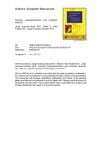TLDR Lichen planus pigmentosus is hard to treat and may be more common in North Africa than previously thought.
The study reported on 17 cases of lichen planus pigmentosus (LPPig) in Moroccan patients, highlighting its presence in North Africa, a region where it was previously underreported. The study included 1 man and 16 women, with a mean age of 57.4 years. The condition predominantly affected the face, particularly the perioral area and forehead, and was associated with frontal fibrosing alopecia in 41% of cases. Some patients also had thyroiditis or diabetes mellitus. Histological analysis confirmed pigment incontinence and basal vacuolization. Treatment with tranexamic acid and topical hydroquinone showed limited success, with only 4 patients achieving complete resolution. The study concluded that LPPig is a challenging pigmentary disorder to treat, and its prevalence in North Africa may be underestimated.
 17 citations
,
November 2018 in “Dermatology”
17 citations
,
November 2018 in “Dermatology” Most patients with frontal fibrosing alopecia had facial bumps, with Hispanic/Latino and premenopausal women being more affected, suggesting a more severe condition.
 94 citations
,
October 2017 in “International Journal of Dermatology”
94 citations
,
October 2017 in “International Journal of Dermatology” Lichen planus pigmentosus causes dark skin patches and is treated by avoiding triggers and using anti-inflammatory medications.
 1 citations
,
January 2021 in “Journal of the Dermatology Nurses’ Association”
1 citations
,
January 2021 in “Journal of the Dermatology Nurses’ Association” The convention discussed various skin conditions and treatments, and highlighted the importance of vaccinations for patients on immune-altering medications.
 March 2014 in “Journal of The American Academy of Dermatology”
March 2014 in “Journal of The American Academy of Dermatology” The document lists various dermatology topics, treatments, and diagnostic methods.
 1 citations
,
June 2024 in “British Journal of Dermatology”
1 citations
,
June 2024 in “British Journal of Dermatology” Mycophenolate mofetil effectively improved skin pigmentation and itching in a woman with lichen planus pigmentosus and frontal fibrosing alopecia.
 1 citations
,
April 2016 in “The American Journal of the Medical Sciences”
1 citations
,
April 2016 in “The American Journal of the Medical Sciences” The document concludes that doctors should check for frontal fibrosing alopecia in patients with acquired hyperpigmentation and that early treatment is important.
 September 2024 in “Journal of the American Academy of Dermatology”
September 2024 in “Journal of the American Academy of Dermatology” Phenoxyethanol in hair growth products may be linked to frontal fibrosing alopecia.







